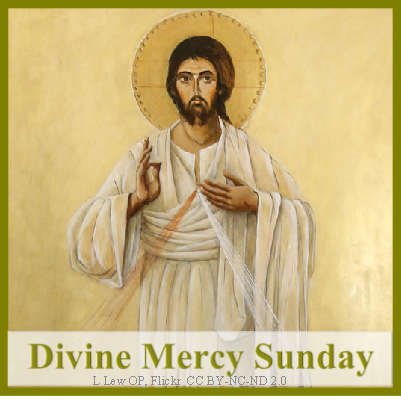Readings: Acts 2:42-47; 1 Peter 1: 3-9; John 20:19 – 31
Today’s gospel reading from John reports three distinct but related events:
a) on the evening of first day of the week (Sunday) the appearance of the Risen Jesus to his disciples locked behind closed doors ‘for fear of the Jews’;
b) Jesus’ commissioning of his disciples to continue his mission of forgiveness and peace; and
c), eight days later, Jesus’ second appearance to his disciples, this time in the company of Thomas, who acknowledges that Jesus is truly risen when he touches the wounds in his risen body. The reading climaxes in Thomas’ great acclamation of faith: ‘My Lord and my God’ (Jn 20:28).
The natural thing to do, when we feel anxious or threatened. is to withdraw to a safe place, lock the doors, and wait for the danger to pass. This is precisely what the disciples of Jesus do following the capture, torture and horrific death of their master. Despite the witness of Mary Magdalene, they remain paralysed by their fear, sense of failure, and perhaps also by guilt at having deserted their master at the end. It is in such a confused state that the Risen Jesus comes to them, not with words of blame or recrimination, but with his peace. His first words are ‘Peace be with you’ (Jn 20:19). The importance of this greeting is highlighted by being repeated three times in today’s gospel passage.
We usually think of peace as the absence of conflict and turmoil, the ending of all those things that make us anxious and fearful – and there are indeed many reasons for us to be anxious and fearful in our world today. However, the peace Jesus offers is something more profound than the absence of conflict or the resolution of difficulties. Earlier in John’s Gospel, Jesus says to his disciples: ‘My peace I leave with you; my peace I give to you. I do not give to you as the world gives. Do not let your hearts be troubled, and do not let them be afraid’ (Jn 14:27). The peace Jesus gives is not the kind of peace the world around us can provide, not something that we can create from our own resources. It is a peace that can only be received as a gift ‘from above’ – a gift that enables us to live freely and even joyfully in the midst of strife, stress and conflict.
Having freed his disciples from the prison of their own making by his gift of peace, the Risen Jesus immediately commissions them to continue his mission of peace and forgiveness. For this, he empowers them with the gift of the Spirit. ‘As the Father sent me, so am I sending you. After saying this he breathed on them and said: Receive the Holy Spirit. For those whose sins you forgive, they are forgiven; for those whose sins you retain, they are retained’ (Jn 20:21-23). As the Risen Jesus came to his disciples, so he comes to us today in the midst of our fears, doubts, pain and confusion. He comes offering us his peace and breathing into our anxious hearts the empowering breath of the Spirit, embolding us to continue his healing mission of peace and forgiveness.
John tells us that the apostle, Thomas, was not with the group of disciples when Jesus first appeared, though he doesn’t tell us why. Perhaps distancing himself from his erstwhile companions was his way of coping with his grief and disillusionment at what had happened to his master. However, the following Sunday, Thomas is with them when Jesus appears again to his disciples, openly bearing in his Risen body the scars of his traumatic recent history. It is surely significant that Jesus does not hide his wounds but invites the ‘doubting’ Thomas to touch them and ‘doubt no longer but believe’ (Jn 20:27). The wounds in Jesus’ risen body are not old wounds, but wounds so raw that Thomas can place his finger inside them, as so vividly portrayed in the famous painting of this scene by Caravaggio. And it is this intensely physical contact with the wounds of Jesus’ risen body that draws from Thomas the greatest act of faith in the entire Bible: ‘My Lord and my God’ (Jn 20: 28).
Besides demonstrating that the Risen Jesus is the same crucified Jesus of Nazareth whom Thomas and the disciples had known and loved, these wounds of the Risen Christ also remind us of the terrible wounds that mar our world today, including the Church, the sacramental body of the Lord – wounds we are challenged to embrace with faith, rather than withdraw from in fear. Like Thomas, we, too, are invited to bury our doubts, fears and confusion in the open wounds of the Risen Jesus. As the prophet Isaiah reminds us: ‘By his wounds we are healed’ (Is 54:5). I end with some lines from the poem, Jesus of the Scars by Edward Shillito, a poet who lived through the horrors of World War I:
‘If we have never sought, we seek Thee now;
Thine eyes burn through the dark, our only stars;
We must have sight of thorn-pricks on Thy brow,
We must have Thee, O Jesus of the Scars.
The heavens frighten us; they are too calm;
In all the universe we have no place.
Our wounds are hurting us; where is the balm?
Lord Jesus, by Thy Scars, we claim Thy grace’
On this Divine Mercy Sunday, and in these difficult and confusing times, we pray that we will find our solace, hope, and courage in the wounded, risen Christ.
Fr Michael McCabe SMA
To listen to an alternative Homily for this Sunday, from Fr Tom Casey of the SMA Media Centre, Ndola, Zambia please click on the play button below.
|
|

